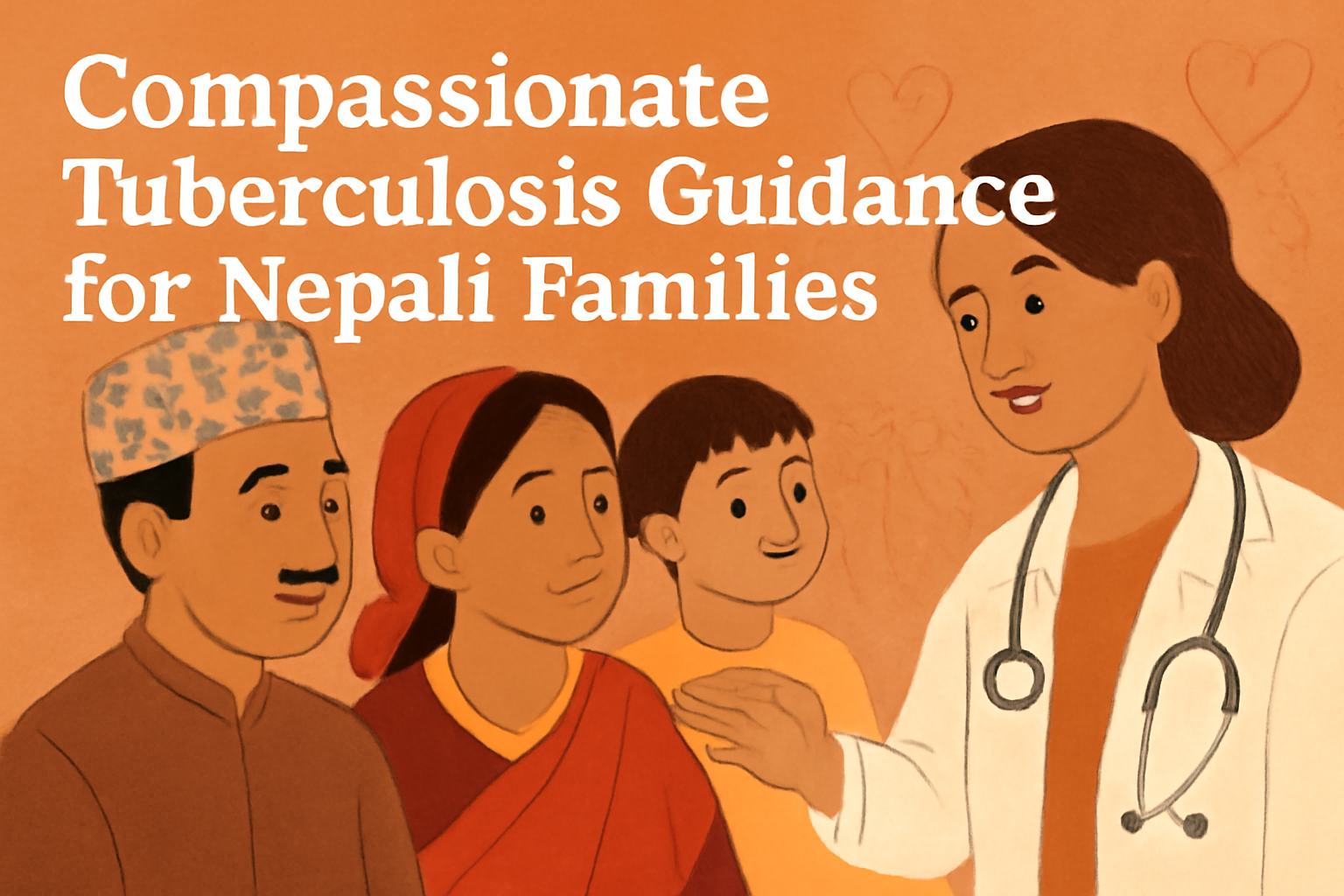Empowering Nepali families, healthcare workers, and communities with vital knowledge on tuberculosis – compassionate, clear, and life-saving.
1. Introduction: The TB Landscape in Nepal
- A heavy burden: Nepal sees around 69,000 new TB cases annually, with roughly 17,000 deaths each year (myRepublica, The Kathmandu Post).
- Hidden epidemic: Surveys show only about 37,000–40,000 cases are reported, leaving over 30,000 undiagnosed and untreated (The Kathmandu Post, nepallivetoday, World Health Organization).
- Encouraging progress: Nepal’s National Strategic Plan (2021–2026) under the National TB Program (NTP) aims for universal access to diagnosis and treatment, expanding tools like GeneXpert, and engaging communities through the TB Free Nepal initiative (Public Health Concern Nepal – PHC- Nepal, World Health Organization).
- Today, treatment success for drug-sensitive TB is around 92%, and the fatal burden is decreasing year by year (Public Health Concern Nepal – PHC- Nepal).
2. Recognizing TB Symptoms: When to Seek Help
Early detection can be life-saving.
Common Symptoms to Watch For:
- Persistent cough lasting more than 2–3 weeks (with or without blood)
- Unexplained weight loss, night sweats, fever, fatigue
What Progression Looks Like:
- Symptoms gradually worsen over weeks if untreated
- May spread to others, especially in close, poorly ventilated homes
⏱ Action Checklist:
- �� Do you or anyone have a cough lasting over two weeks?
- �� Are night sweats, weight loss, or fever present?
- → If yes, seek medical evaluation right away—don’t wait.
3. Getting Diagnosed in Nepal
Where to Go:
- Microscopy centers (over 600 nationwide), GeneXpert sites, and NTCC reference labs provide TB testing (Wikipedia, Public Health Concern Nepal – PHC- Nepal).
- Accessible at government hospitals, district health posts, and select private clinics.
Types of Tests:
- Sputum smear microscopy
- GeneXpert MTB/RIF (rapid and detects rifampicin resistance)
- Chest X-ray and culture/drug susceptibility testing at central labs (World Health Organization, Wikipedia).
What to Expect & Cost:
- Free testing and treatment under the NTP, including DOTS centers (~5,900 across Nepal) (The Kathmandu Post, Wikipedia).
- Minimal travel or administrative costs; ask your local clinic for support options.
4. Treatment Options & Process
DOTS Therapy
- Directly Observed Treatment, Short-Course (DOTS) ensures medication is taken under supervision and follows global WHO guidelines (Wikipedia).
- Standard duration: 6 to 9 months, depending on drug sensitivity.
Medication Schedules:
- Intensive Phase: 2 months of 4-drug regimen (usually daily, supervised)
- Continuation Phase: 4–7 months with fewer drugs
Managing Side Effects:
- Common: nausea, mild liver issues, joint pain
- Tips: take with food, communicate symptoms early, keep follow-up appointments
- NTP facilities can guide you through managing side effects.
Drug-Resistant TB (DR-TB):
- Estimated ~2,800 MDR/RR-TB cases yearly, but only ~700 detected (www.slideshare.net, nepallivetoday, The Kathmandu Post).
- Specialized centers offer longer, more complex treatment regimens.
5. Prevention Strategies: Protect Your Household
- Improved ventilation: Keep windows open, use fans
- Cough etiquette: Cover mouth with elbow or tissue, dispose safely
- Masking: Especially when around active TB cases
- Community programs through TB Free Nepal encourage case finding and preventive action (Public Health Concern Nepal – PHC- Nepal, nepallivetoday).
6. Living with TB: Support & Well-Being
Nutrition & Lifestyle:
- Eat balanced meals rich in proteins, vitamins, and calories
- Prioritize rest but stay moderately active as health improves
Family Support:
- Encourage adherence, assist with reminders, and accompany patients to visits
- Ensure good ventilation and nutrition at home
Fighting Stigma:
- TB is not genetic, a curse, or a sign of weakness—it’s an infectious disease that can be cured (The Times of India, Medical News Today).
- Share accurate information with friends, neighbors, and communities.
7. Resources in Nepal: Where to Turn
- NTCC & National TB Program: central coordination, surveillance, and strategic planning
- DOTS centers in health posts, hospitals, and private clinics (~5,900)
- GeneXpert sites (~117), microscopy labs (~786), and DR-TB treatment facilities (~23) (Public Health Concern Nepal – PHC- Nepal).
- Support Hotlines & NGOs: Reach out locally for counseling, guidance, and help with transportation or nutrition support.
- Emergency Contacts: Visit your nearest health post, call the TB helpline at NTCC, or dial 1133 (Health Desk, if available locally).
8. FAQ: Common Questions from Families
| Question | Answer |
|---|---|
| Is treatment really free? | Yes—government facilities under NTP provide free TB treatment at DOTS centers. |
| Can I get treatment in rural areas? | DOTS centers and microscopy labs are widely available, even in remote areas. |
| What happens if I stop treatment early? | Stopping early risks treatment failure, relapse, and drug resistance. Always complete the full course. |
| Can TB spread in the house? | Yes—but simple steps like covering coughs and improving airflow can reduce risks significantly. |
| Are children at risk? | Yes, especially younger ones. If someone in the home has TB, children should be screened. |
| What about myths? | TB isn’t genetic or only for the poor, and masks, not touch, protect from spread (The Times of India, Medical News Today). |
9. Conclusion: A Beacon of Hope
TB in Nepal is curable, preventable, and treatable, thanks to free government services, the widespread DOTS program, and modern diagnostics like GeneXpert. With ongoing national efforts like TB Free Nepal, strong community support, and aware families, we can hope to end TB together.
You are not alone. Help is available—reach out, adhere to treatment, and together we will build a TB-free Nepal.
This article is designed to be mobile-friendly, deeply informative, and genuinely helpful—built to serve Nepali families, TB patients, healthcare workers, and communities for improved awareness and action.
